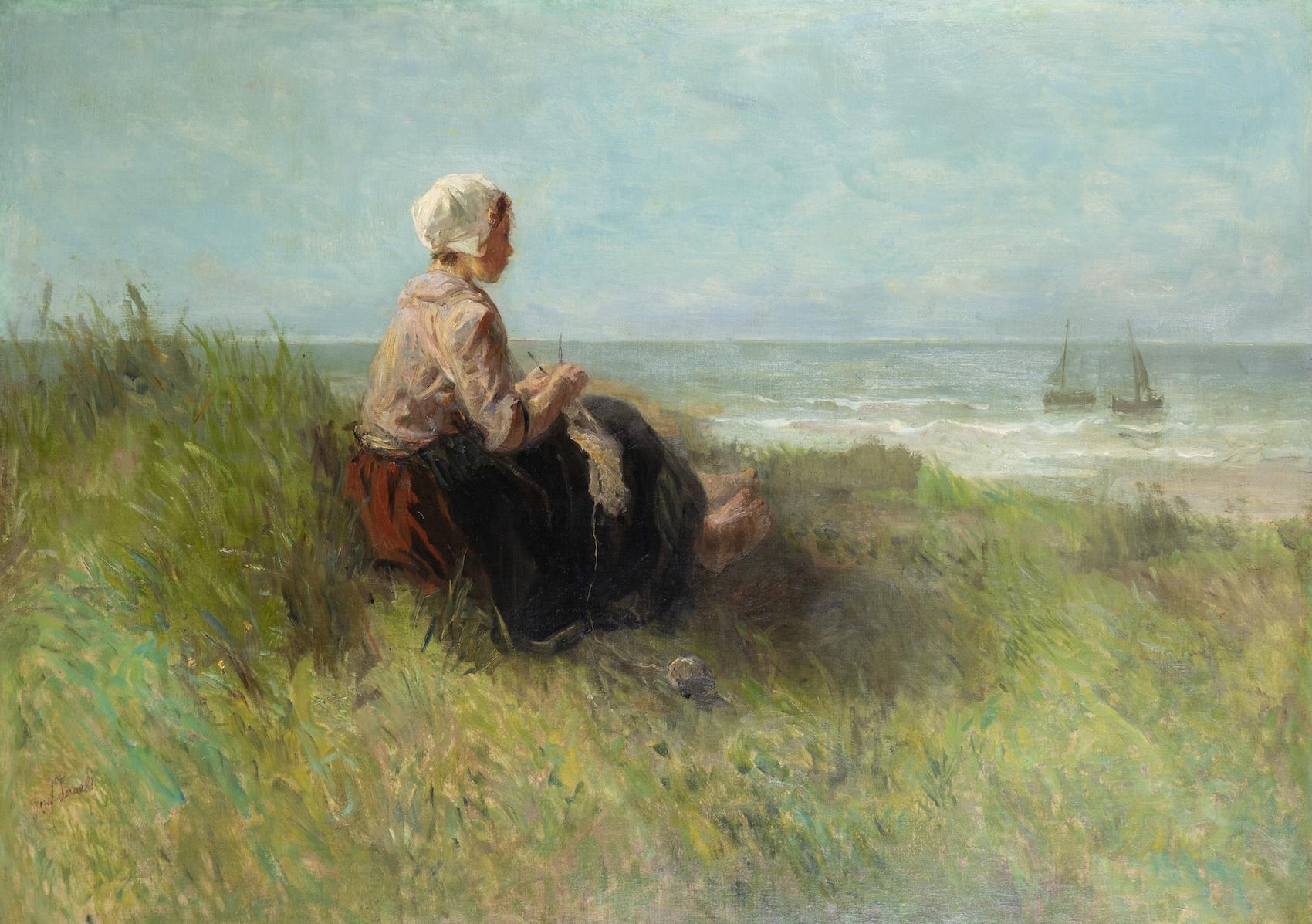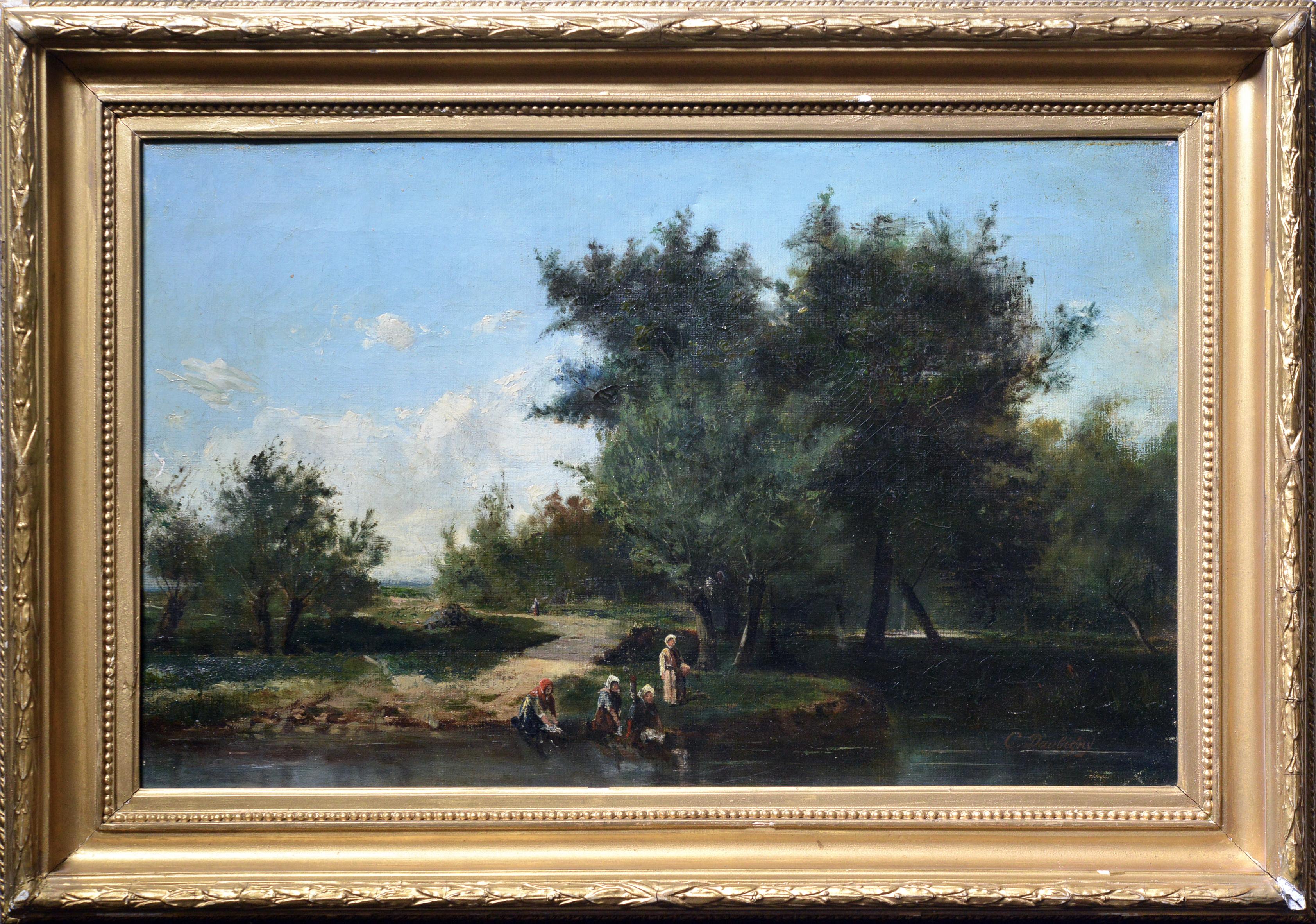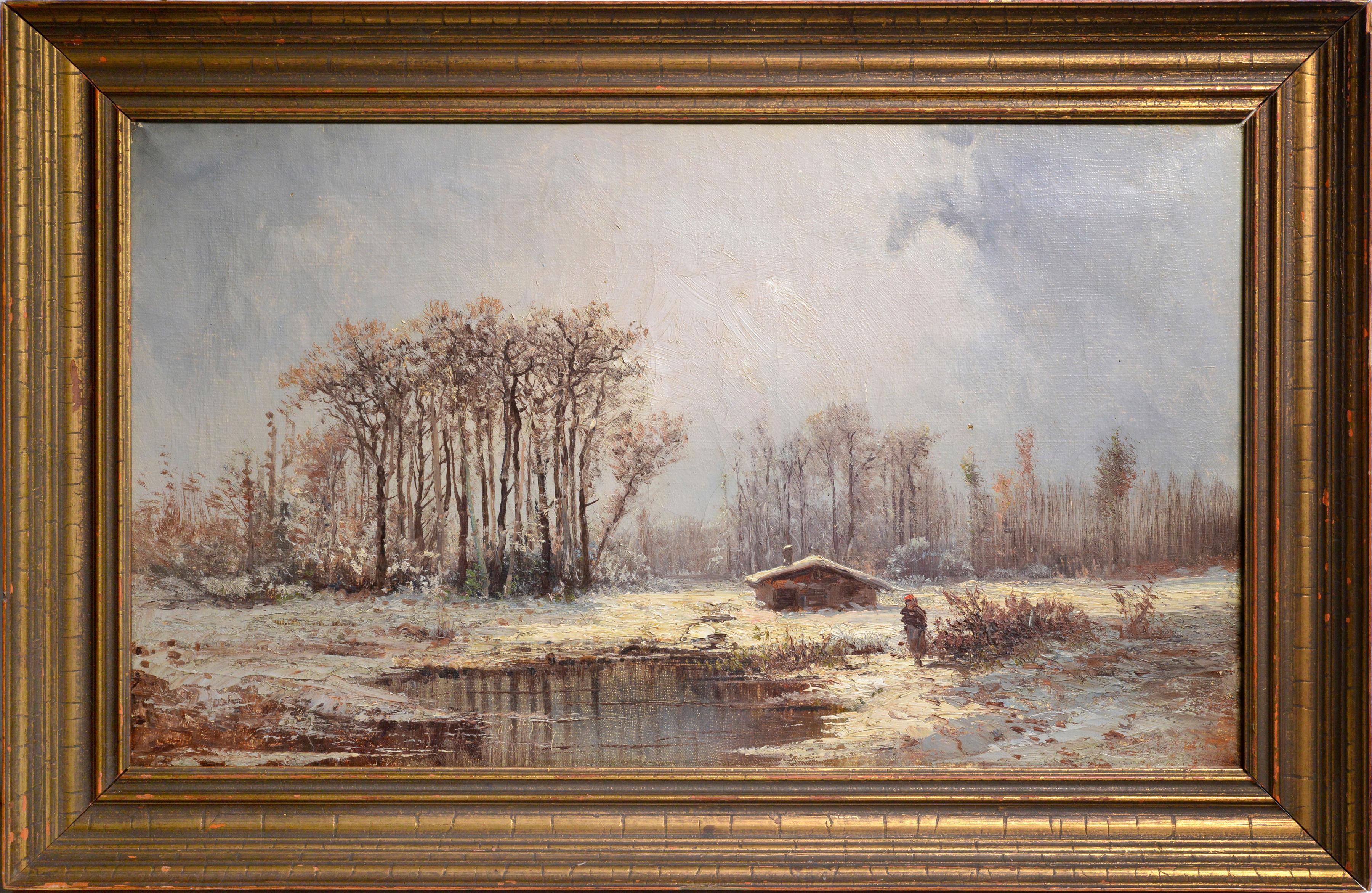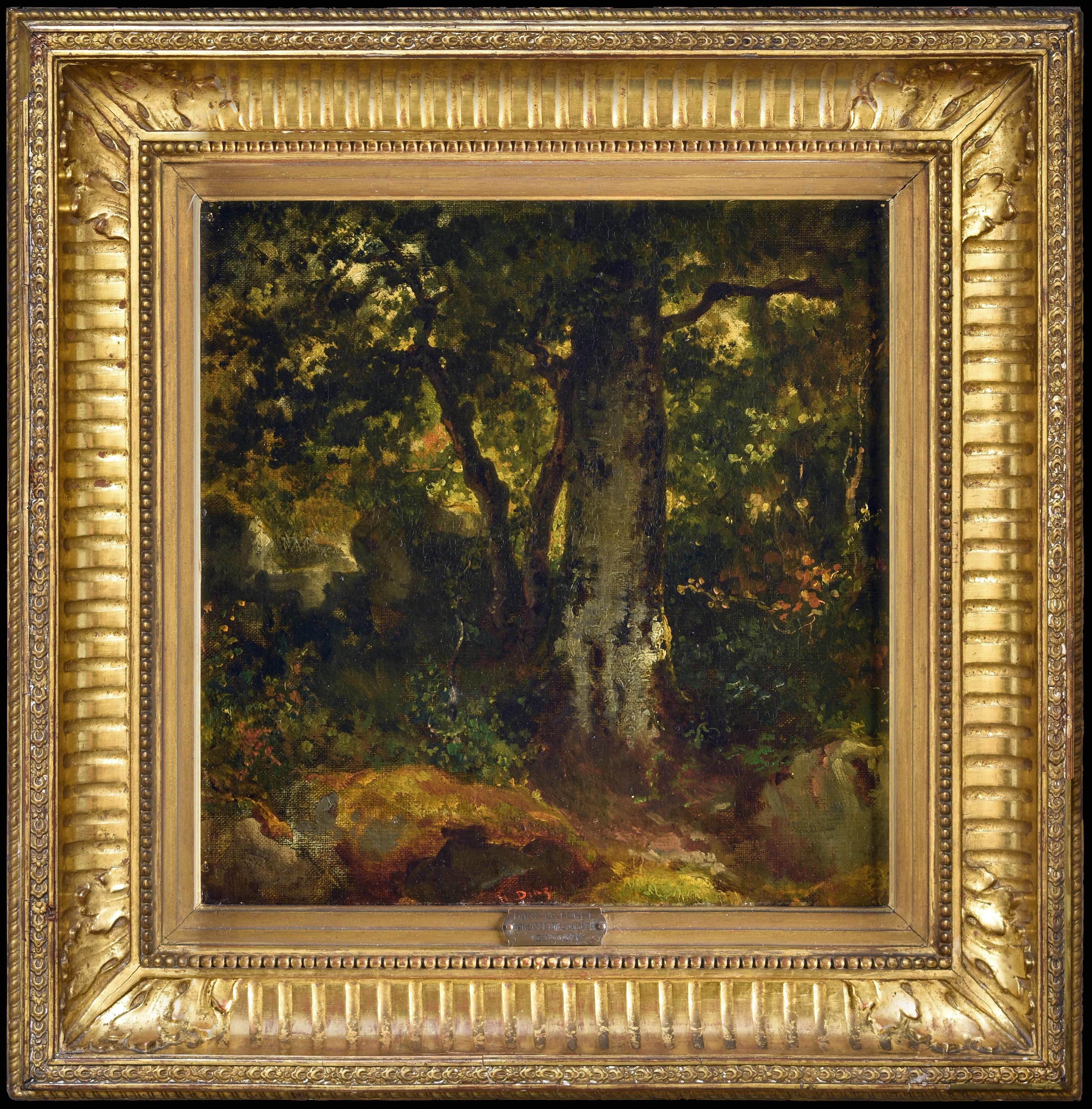Items Similar to Barbizon Period English Landscape, Oil on Canvas, Circle of John Constable
Video Loading
Want more images or videos?
Request additional images or videos from the seller
1 of 19
Alfred VickersBarbizon Period English Landscape, Oil on Canvas, Circle of John Constable1840s
1840s
About the Item
Barbizon Period mid 19th Century oil on canvas English rural landscape by Alfred Vickers, Signed bottom right with old collectors label to the rear stretcher. Presented in fine custom carved wood and gilt frame.
A charming rural landscape of a road leading down to the sea or a river, perhaps Vickers beloved Isle of Wight or the Medway. A central figure catches the eye, cottages to her right, smoke drifting lazily from their chimneys. A copse of trees painted in a style reminiscent of the work of Constable as is the handling of the sky. Vickers has created a wonderful perspective in the painting that takes the eye all the way through the painting as if on a journey in the landscape itself.
British artist Alfred Vickers is predominantly known for his rugged landscapes, which depict scenic views from the mountains of North Wales to the lowlands of Kent. He was an important contributor to the development of naturalistic landscape painting.
Painting at the same time as the Barbizon School in France, back in England, the appreciation of this style was minimal, virtually non-existent. The press criticised the emerging techniques of the French, believing them to be indulgent whims of deluded young men. So when Alfred Vickers, who was also inspired by John Constable, began producing rapid, sketchy depictions of a land he adored, the critics were nonplussed.
Vickers worked at the same time as the Barbizon School but unlike, Corot, Dupré and his cohorts, he didn't receive a classical education or train with a master. In fact, he gained an apprenticeship under a house painter and was born into humble beginnings. But despite the different paths, the results were the same - a genuine attempt to paint nature truthfully, in all its changing moods.
In a strange contradiction, despite his lack of popularity, the Royal Academy did show many of his paintings, 62 in total. Yet, the press rarely mentioned him, preferring to celebrate the works of the established elite, the Academy men who wore the right suit. Vickers was an outsider, diligently carrying out his work across much of the United Kingdom including Wales, Derbyshire, the Isle of Wight, the New Forest, Kent and Hampshire.
One critic admired his ‘honest work’.
“Those who go to picture exhibitions to feel the velvets and the damasks, and to be made to exclaim “how exactly like” this, that, and the other painted object is, need not trouble themselves to look at these pictures of Alfred Vickers. But those who can enjoy the simple oft-told pastoral of the bubbling brook beneath the leafy trees, the cows driven home at milking time by the road through the wood, the rustic figures, the peeps of blue distance seen beyond, and a hundred passages of homely charm and beauty, true, but not less so for being common, will find them here. These are what we admire in the honest work of this painter, whose life was spent in feasting on natural beauty, though he well-nigh starved at last.”
Vickers was early, as important as the Barbizon School, and a precursor to loose naturalistic landscape painting as we know it.
Vickers is represented in various public collections including The Wilson, Cheltenham, Reading Museum, Leicester Museum, The National Trust, Sheffield Museum, Wolverhampton Art Gallery, Guildhall Art Gallery, Russell Cotes Art Gallery & Museum, Canterbury Museum, and Nottingham City Museum. He exhibited at the Royal Academy (62 works), British Institute (125 works) and Society of British Artists.
- Creator:Alfred Vickers (1786 - 1876, British)
- Creation Year:1840s
- Dimensions:Height: 12.21 in (31 cm)Width: 16.54 in (42 cm)Depth: 1.78 in (4.5 cm)
- Medium:
- Movement & Style:
- Period:
- Condition:In good overall condition commensurate with age. There are two areas of expert old restoration top centre not visible from the front (see photos).
- Gallery Location:Cotignac, FR
- Reference Number:
Alfred Vickers
Alfred Vickers was a painter of marine subjects and landscapes. He exhibited extensively throughout his life but notably at the Royal Academy (125 works), at Suffolk Street (81 works), and at the British Institution. Vicker's sparkling light and rapid style has been compared to that of Boudin. Vickers painted many coastal views, particularly in the area of the Isle of White and the Solent. Works by Vickers are in Glasgow, Nottingham, and Sheffield Art Galleries. This is one of the finest quality Vickers I've ever seen let alone owned. At his best Vickers could paint with a lightness and quality rarely seen in British art outside of John Constable or the finest work by Patrick Nasmyth.
About the Seller
5.0
Platinum Seller
These expertly vetted sellers are 1stDibs' most experienced sellers and are rated highest by our customers.
Established in 2000
1stDibs seller since 2020
165 sales on 1stDibs
Typical response time: 1 hour
- ShippingRetrieving quote...Ships From: Cotignac, France
- Return PolicyA return for this item may be initiated within 3 days of delivery.
More From This SellerView All
- Le Puits, The Water Well Amidst Romantic RuinsLocated in Cotignac, FROil on board view of a water well set amidst romantic ruins and foliage with a figure, by L Masson. Signed bottom left presented in wood frame. There is a c...Category
Mid-20th Century Barbizon School Landscape Paintings
MaterialsBoard, Oil
- Orientalist Beach Scene, Chenoua Plage, Algerie, Oil On Canvas.Located in Cotignac, FRAn Orientalist beach scene of the coast of Algeria at Chenoua by French painter Gustave Lino. The painting is signed, located and dated bottom left. Presented in a plain gilt frame. A charming and atmospheric view of a day at the beach. The revellers are enjoying bathing in the Mediterranean, resting under their colourful parasols against the sun and exploring the far off rocks of the cove. The sea gently lapping against the rocks at the shore. A small row boat ready for an excursion. Lino has beautifully captured the feeling of joy and fun that a day at the beach brings. Gustave Lino was born in 1893 in Mulhouse, France. At the age of twenty, he went to Marseille, discovered Provence and the Mediterranean. He was already interested in painting and art from numerous visits to the museum of his hometown, but he had not yet followed any training in this field. In Marseille, far from home and idle, he decides, almost on a whim, to travel to Algiers, without really knowing what he will discover there. He embarked for Algiers at the age of 19 in 1912. He exhibited with his friends Romeo Charles Aglietti in 1914 at 'Herero' in Algiers. Unfortunately in 1914 in Corsica in Ajaccio, being of German nationality and Mulhouse being part of the German Empire since 1871, he was interned as a 'civilian'. He spent the First World War in the Isle of Beauty but spent his time wisely developing his artistic skills. He realised many paintings as well as the historical decorations of the Solferino Hotel in Ajaccio and the religious decorations of the castle of Malaspena-Massa in Belgodère. In December 1918, he returned to Algiers where he was a pupil of Georges-Antoine Rochegrosse. He exhibited at the Salon des Artistes Français from 1926 and at the Danton gallery, rue La Boétie in 1927. He settled permanently in Algiers and then in Bou-Saada. Back in Algeria, he took a close interest in the painting of Albert Marquet, which particularly seduced him and with whom he became a close friend. The transparent sharpness, this harmony of lines and tones becomes his ideal of perfection. He specialised in Algerian seascapes and landscapes, a colourist above all. Becoming an adopted member of the group called "Painters of Poetic Reality" (with Jean...Category
Mid-20th Century Impressionist Landscape Paintings
MaterialsCanvas, Oil
- Mid-Century Oil on Canvas. Harbour scene. Farewell to the Fishermen.Located in Cotignac, FRMid 20th century oil on canvas of a crowded harbour scene, showing the local fisherman or sailors saying farewell to their families before going to sea. The painting is signed bottom right but the artist remains as yet unidentified. A colourful yet slightly brooding and dreamlike painting. The figures are faceless and the shapes loose and undefined reminiscent of the works by Balthus who in turn was influenced by LS Lowry and his scenes of industrial districts. The colours are deep and glowing and the shapes of the figures are rounded giving a sense of warmth and evoking the quality of light seen at either dawn or dusk. Balthasar Klossowski de Rola (February 29, 1908 – February 18, 2001), known as Balthus, was a Polish-French modern artist. He is known for his erotically charged images of pubescent girls, but also for the refined, dreamlike quality of his imagery. Lowry is famous for painting scenes of life in the industrial districts of North West England in the mid-20th century. He developed a distinctive style of painting and is best known for his urban landscapes peopled with human figures often referred to as "matchstick men".Category
Mid-20th Century Modern Figurative Paintings
MaterialsCanvas, Oil
- French Village Landscape, Trees and The Square, Gassin.Located in Cotignac, FRAn important oil on canvas village landscape, probably Gassin in the South of France, by noted Dutch painter Willem Anthonie 'Wim' Oepts. The painting carries the atelier stamp botto...Category
Mid-20th Century Fauvist Landscape Paintings
MaterialsCanvas, Oil
- The Cottage, A Rural Idyll, Large Scale French Country Landscape. Oil on Canvas.Located in Cotignac, FRA large scale oil on canvas landscape painting of a thatched cottage with a far view to a church spire beyond a lake by Percy. The painting is signed bottom right and is presented in...Category
Late 20th Century Romantic Landscape Paintings
MaterialsCanvas, Oil
- Montparnasse School Mid Century Street View, Circle of Takanori Oguiss & FoujitaLocated in Cotignac, FR1960s oil on canvas view of the streets around Montparnasse, Paris by Osamu Komma 近馬 治. The painting is signed and dated bottom left and there is script to the back of the canvas. ミッ...Category
Mid-20th Century Landscape Paintings
MaterialsCanvas, Oil
You May Also Like
- Waiting by Jozef Israëls - Landscape oil paintingBy Jozef IsraëlsLocated in London, GBWaiting by Jozef Israëls (1824-1911) Oil on canvas 95.3 x 133.9 cm (37 ½ x 52 ¾ inches) Signed lower left, Jozef Israels A monumental painting by one of...Category
19th Century Barbizon School Figurative Paintings
MaterialsCanvas, Oil
- Laundresses on River 19th century Barbizonian Landscape by French MasterLocated in Stockholm, SESigned lower right "C. Daubigny". As we gaze upon the painting, we are immediately drawn to the foreground, where a small group of women are diligently washing clothes on the banks o...Category
Mid-19th Century Barbizon School Landscape Paintings
MaterialsCanvas, Wood, Cotton Canvas, Oil
- Spanish school landscape with river oil painting SpainLocated in Barcelona, BarcelonaOil on canvas glued to board. Oil measures 25x40 cm. Frameless. Illegible signature.Category
1920s Barbizon School Landscape Paintings
MaterialsCanvas, Oil, Board
- River Cottage 1849/ Barbizon landscape heralding Impressionism Jongkind's friendBy Henri SieuracLocated in Norwich, GBA wonderful view of a river landscape with a rustic cottage and pollarded trees by Henri Sieurac. It isa rare, early and very fresh landscape by this Parisian artist which may well have been painted in the countryside around Barbizon, near the river Loing. Henry Sieurac had studied with his father, François Joseph Sieurac , and of Paul Delaroche...Category
1840s Barbizon School Landscape Paintings
MaterialsOil, Canvas
- Spring Thaw Barbizon Landscape 19th century Oil painting by French ImpressionistBy Emile GodchauxLocated in Stockholm, SEOne of early of the French artist’s works by Emile Godchaux (fra.: Émile Godchaux, 1860 - 1938), late 19th century. This amazing landscape takes us to a cloudy spring day, making us ...Category
Late 19th Century Barbizon School Landscape Paintings
MaterialsCanvas, Oil, Wood
- Dans la forêt, Barbizon forestBy Narcisse Virgilio Díaz de la PeñaLocated in Brooklyn, NYNarcisse Diaz de la Peña (1807–1876) was a French painter associated with the Barbizon School, a group of artists who focused on naturalistic landscape painting. He was born on Augus...Category
Mid-19th Century Barbizon School Landscape Paintings
MaterialsCanvas, Oil




